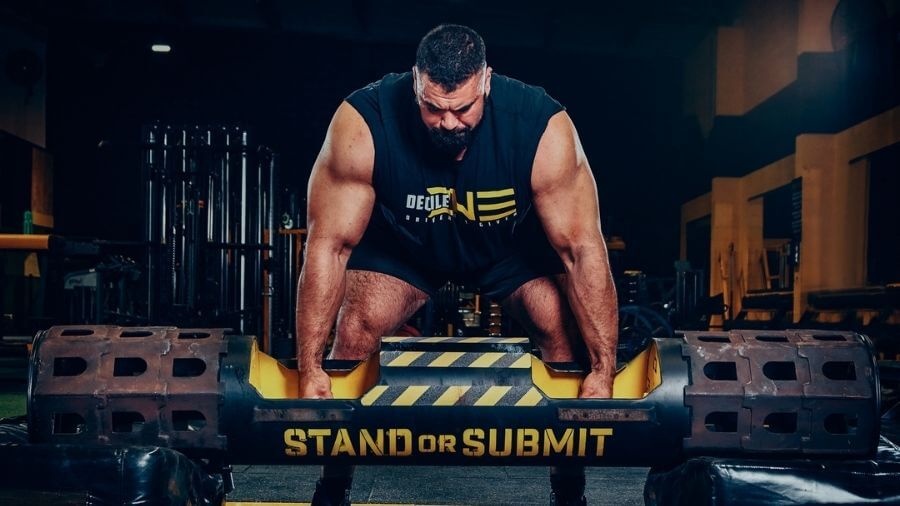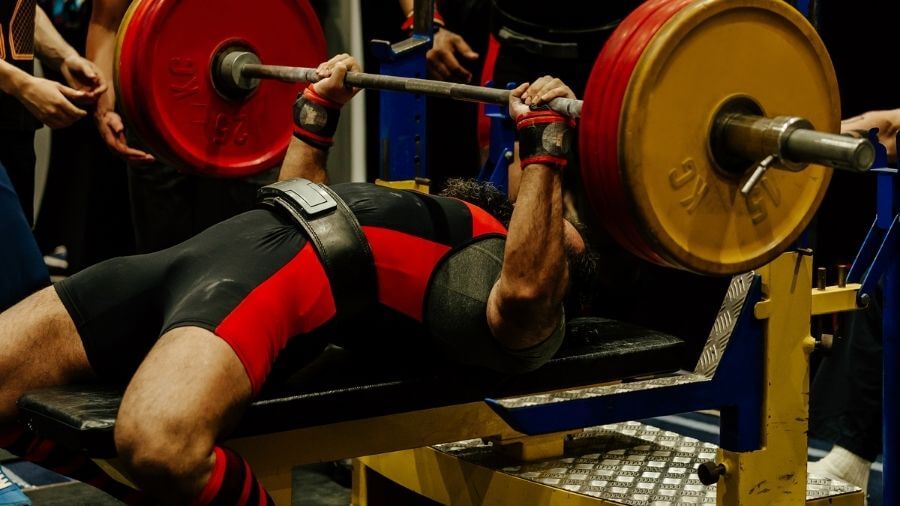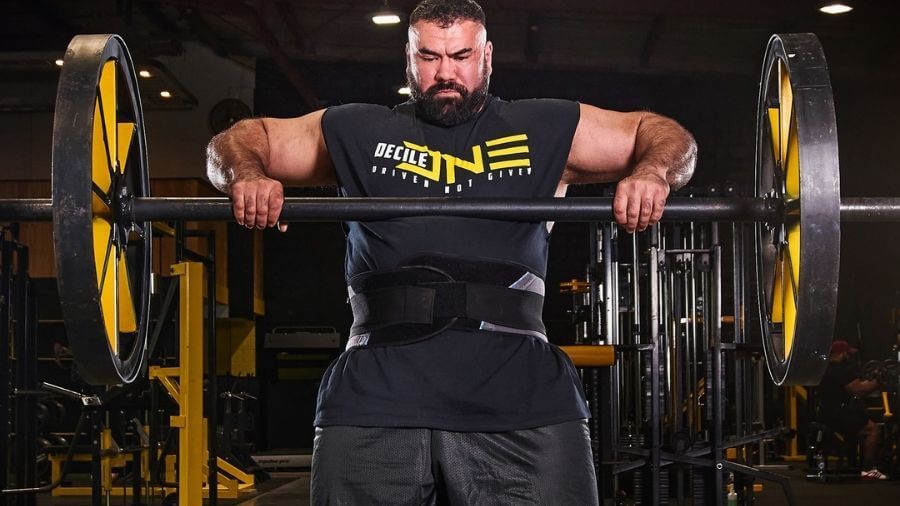Strongman and Powerlifting are two popular strength sports. You'll likely recognize Strongman from the good ol' days of ESPN featuring World's Strongest Man events. At the same time, Powerlifting has grown immensely in popularity over the past two decades. But what makes them so different?
The main difference between Strongman and Powerlifting is the competitive events. Strongman contest for max reps, weight, or time with overhead, loading, or carrying events. Powerlifters contest for one rep max for the squat, bench press, and deadlift.
But these aren't the only differences. Did you know that there are no set competition lifts in a Strongman competition? Often, athletes won't even know what the events are until the week of the competition!
Table of Contents
What Is Strongman?
Strongman is like the mixed martial arts of strength sports. It encompasses elements from Powerlifting, Olympic Weightlifting, and the Highland Games and blends them with its own flavor.
That is why you get a mixture of heavy lifting, max rep, throwing, moving, and loading events all smashed together into one competition.
When Strongman first started, it wasn't a sport you trained for. It was a competition where strength athletes from different disciplines would come to compete to see who the Strongest man was.
In the modern era, athletes dedicate their abilities to the sport of Strongman training, specifically for the sport.
What Is Powerlifting?
Powerlifting is contested over three lifts: squat, bench press, and deadlift, also known as the big three. The lifter who lifts the most weight when all three are totaled is the winner. Powerlifting is contested in weight classes to maintain a fair playing field.
However, an overall best lifter is also crowned by calculating a Wilks score. Essentially a calculation for strength relative to bodyweight.
What you may find in Powerlifting is the sheer number of people claiming to be world record holders or champions.
The fracturing of Powerlifting means there is no one organization running competitions. Many Powerlifting federations have their own rules and records, leading to multiple "champions."
You can break it down further into raw and equipped Powerlifting. Raw Powerlifting allows minimal assistive gear, whereas equipped Powerlifting allows special suits that act as stiff springs to help the lifter lift more weight.
Strongman vs. Powerlifting Key Differences

Strongman and Powerlifting are very different sports, although they often share similar training principles. Let’s highlight these key differences.
Competition Lifts
The most obvious difference is the competition lifts. Strongman competitions consist of three main categories:
You can place the most common events into these categories. These can either be done for reps, time, or max weight. The events are never the same from competition to competition, so a Strongman must be well rounded. On the other hand, Powerlifting is always contested over the same three lifts:
Competitions are always held in the same order. Squat first, then bench press, then deadlift. You have nine total attempts (3 each lift). The only variation you'll have from competition to competition is the time you need to wait between exercises. This will depend on how big the flight of athletes is.
While Strongmen also perform the squat and deadlift in competition, they don’t have rules about technique. Powerlifters must have the hip crease below the knee when squatting to be a good lift. You must lock out the deadlift without "hitching" against the legs.
Strongmen don’t have these restrictions. It’s get the weight up any way possible to have the rep counted.
Physical Requirements
Powerlifting is a pure strength sport. How much weight can you lift for one rep. You have 9 lifts in a competition with plenty of rest between. There is no endurance requirement. While needing to be damn strong, Strongman has a high endurance requirement that needs to be developed.
These could be medleys of a similar exercise (e.g., overhead) or loading races. Essentially, you need the ability to carry something heavy repeatedly at speed. This makes Strongman a hybrid strength sport where you must train multiple qualities to maximize performance.
For example, a 50 m sled drag has similar cardiovascular demands to a 17-minute weight training circuit, even though a 50 m sled drag takes about 1 minute [1].
Weight Classes
At the highest level, Strongman doesn't have weight classes. Unfortunately, if you're a small human being, you'll never make it to the big leagues. However, there are often weight classes at the lower level to bring new lifters to the sport. You'll see at a local Strongman competition under 90 kg, and 105 kg are typical weight classes.
Powerlifting is a weight class sport. You can move between weight classes throughout your career as you get bigger and stronger. Or if you want to take advantage of weight cutting to be a larger person in a smaller weight class. Here are the Powerlifting weight classes for men and women:
Men
Women
Equipment
Raw Powerlifting has similar equipment rules to Strongman. Sleeves, wraps, and belts are all permitted. However, the Strongman gets an extra accessory for deadlifting and is allowed to use straps.
Equipped Powerlifters use special suits that act as stiff springs allowing them to lift weights much heavier than when raw. Some Strongman competitions allow Powerlifting suits but it is not a staple between all competitions.
Regarding shoes, Powerlifters will wear flat shoes for deadlifting like Chuck Taylor’s and Weightlifting shoes for squatting (or flat shoes depending on their preferences). Strongmen will also often wear Weightlifting shoes for loading and squatting events.
However, Strongman shoes change drastically when it comes to moving events. For example, World’s Strongest Man competitor recommends rock climbing shoes for moving events on concrete and rugby boots for moving events on grass. You can see this article for recommendations on the best Strongman shoes.
Accessibility
Powerlifting is accessible to the average lifter. You can powerlift at any commercial gym or create your home gym with only a barbell, squat rack, plates, and a bench. Strongman requires the same gear, but you need space to store things like yokes, frames, stones, and other odd objects to carry and load.
If you have a Strongman gym nearby, you're good to go. But these are rare. You're more likely to have a commercial gym around the corner than a hardcore Strongman gym. Further, if you are creating your gym at home, you need the space to store and carry these implements.
Training

Some Strongman competitions, you don't know the events until the week of the competition, making preparation challenging. However, some competitions will release the events 6-8 weeks out or earlier. But that doesn't mean those will be your events.
They can often change on competition day at both the pro and local level so you must be prepared for anything.
As you know the events in Powerlifting, designing a training program is much easier. You can detail every piece from exercise selection, intensity, and volume to peak for squat, bench press, and deadlift.
Powerlifters will typically have 3 to 4 days per week of training focusing on a specific competition lift—for example, a squat, bench press, and deadlift day. A fourth day might be an overhead emphasis day to get more upper body volume. Bodybuilding-style accessories are typically performed following the main lifts to develop muscle mass and strength without the stress of heavy loading.
The way training programs are designed for Strongman in the modern era is not great. They are often 3-day Powerlifting programs with an events day on the weekend.
Unfortunately, it has been this way for at least a decade and hasn't changed.
As you may not know the competition events, or they may change, Strongman training can focus on the main three categories of overhead, loading, and carrying and should be programmed throughout the training week.
For example, you may have one or two overhead days, a deadlift day involving carries, and a squat day involving loading. This is a far better way to program for Strongman in my experience training national level Strongmen and from Colm Woulfe’s experience as a World’s Strongest Man competitor.
You can see this in action in Colm’s 12-Week Off-Season Strongman Program, which uses this same philosophy.
Physique
Powerlifting has a wide range of physiques, from the super muscular to the strong skinny lifter. On the other hand, Strongmen are gigantic muscular humans. There’s no mistaking a Powerlifter for a Strongman and vice versa.
Aside from the pharmaceutical debate, Strongman attracts large humans as the absolute loads used in competition, and large and thick implements are out of reach for the small skinny individual. Strongmen have huge backs, shoulders, and legs to support the large weights they lift.
Powerlifters will also be well developed in these areas. Still, because pure one rep strength is highly neural, you get a wider range of physiques and skinny athletes you'd never imagine putting up huge poundages.
Injury Rates
Strength sports are considered the safest sports to participate in regarding injuries. For example, combining injury data from 15 NCAA sports and averaging injury rates over an entire season shows a 9x greater injury rate per 1000 hours than Powerlifting and a 2x greater injury rate than Strongman [2,3].
Strongman has a much higher injury rate than Powerlifting of 5.5 per 1000 hours vs. 1 per 1000 hours of activity [3]. This is likely due to the awkward nature of Strongman, where odd-shaped implements are pressed, loaded, and carried.
Powerlifting is controlled and involves moving the barbell up and down in a single motion.
Strongman vs. Powerlifting: Which Is Better?

There is no better when comparing Strongman to Powerlifting, especially if doing either sport is for fun. As someone who enjoys lifting, there is no reason you couldn’t do both sports and compete in a Powerlifting and Strongman competition each year.
However, if you want to become an international competitor, there is a better choice depending on your genetics. If you are well over 6 feet tall and capable of reaching a minimum of 140 kg (approx. 315 lbs) of bodyweight, then Strongman is an excellent option.
If there is no way to reach these genetic traits, then highly competitive Strongman is not for you. You'll have a better chance of achieving a high level in Powerlifting.
Does Powerlifting Transfer To Strongman?
Powerlifting does transfer to Strongman. Getting stronger in the big three will always help you as you raise your maximum potential for strength. However, you cannot rely solely on Powerlifting to make you a good Strongman athlete.
You need to practice the events often as there is a skill component even though they may look like brute force exercises. A hybrid approach that implements Powerlifting principles within a Strongman program is how you get the most transfer from Powerlifting to Strongman.
Summary
While sharing training similarities, Strongman and Powerlifting are two different sports on competition day. Preparation should reflect that. The main differences are the competitive events, weight classes, and equipment used, where Strongman has more leeway.
Powerlifting is more accessible for the average lifter as all you need is a barbell, plates, a bench, and a rack. On the other hand, Strongman is much harder to gather equipment. Especially when sourcing Yokes, stones, frames, and odd implements to carry.
References
1. Woulfe, C., Harris, N., Keogh, J., & Wood, M. (2014). The physiology of strongman training. Strength & Conditioning Journal, 36(6), 84-95.
2. Hootman, J. M., Dick, R., & Agel, J. (2007). Epidemiology of collegiate injuries for 15 sports: summary and recommendations for injury prevention initiatives. Journal of athletic training, 42(2), 311.
3. Keogh, J. W., & Winwood, P. W. (2017). The epidemiology of injuries across the weight-training sports. Sports medicine, 47(3), 479-501.
